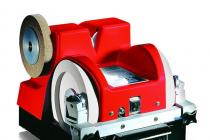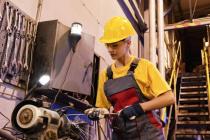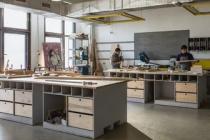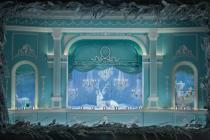As you know, freshly cut wood is not used in production and construction, due to the presence of a large number moisture. Such lumber is called wet. To improve its mechanical and physical performance, a drying chamber for lumber is used. As a result, biological stability increases, the level of strength and other qualities of wood rise.
The need for drying lumber
Previously, in the manufacture of various fakes using wood, timber that was chopped years earlier was used so that they could dry out evenly.
It is very important to get rid of wood moisture. For example, when making wooden furniture from lumber, which is too wet will cause it to dry out over time. After all, a tree can dry out, its size decreases and leads to damage.
Making a door with a very dry material can cause it to swell, causing it to not close. If the door panel is selected from blanks that are dried intermittently in volume, then a rupture may occur or it will warp. Its deformation is noticeable in different planes and at different speeds. As a result, tension lines appear inside the material, which cause cracks.
In addition to the fact that the board is cracking, transverse deformation is also possible, it can arch and raise the edges unevenly.
Basically, cracks in the board are observed along the fibers, initially from the end.
Therefore, all logging is advised to dry. Moreover, drying the wood protects the material from damage by a fungus that destroys the tree, prevents the change in the shape and size of the tree, and improves the physical and mechanical qualities of the wood.

Drying takes long time This procedure is complex and expensive. According to established technologies, the material is heated with superheated steam or hot air flow.
Dried, it lasts longer. And also during use lumber does not give in to deformation. Drying takes place in steam chambers, where damage to the material inside is excluded.
The concept of lumber moisture
Absolute humidity is the percentage of the weight of the liquid present to the weight of the dried material of a specific volume. The presence of relative humidity is characterized by the percentage of the weight of the eliminated liquid (by 2 weighings) to the initial mass of the material.
The usability level is calculated taking into account the relative humidity. The value indicates the readiness of lumber for gluing, drying out. With a moisture value of more than 30%, the tree is considered damp, there is a threat of the formation of a fungal infection.
Moisture in wood is divided into two groups. 
Free moisture- present in cell cavities and intercellular spaces. The presence of such moisture is calculated by the conditions in which the tree grew and how the sawn blanks were stored. When drying, free moisture leaves the board very quickly.
Related (structural)- a liquid that is part of the walls, cells. Each type of wood has its own norm for the presence of structural moisture. Liquid elimination is slow, so drying can take months or years in a typical environment.
Wood is divided into three categories:
- Wet - the relative moisture content is more than 23%.
- Semi-dry - moisture content 18-23%.
- Dry - moisture content value 6–18%.
Moisture indicators of lumber for different types of work
Depending on the purpose of the wooden blank, the material is dried in different ways. Wood is dried to 6–8% moisture if it requires mechanical processing and collection of products for combination with high precision that affect the level of use (skiing, parquet, musical instruments).

The transport presence of moisture contains 18–22%. This presence of water in lumber corresponds to long transits during the warm season. Wood that is dried to this moisture content is most often used in building a house, making containers, or if there is no need for interchangeability during installation.
Carpentry moisture has subspecies. The molded material includes a board for terraces, sheathing, floorboard, in which the humidity should be 15%. Lumber products, such as doors, windows, stairs, made of solid or glued material, endure 8-15% humidity.
Furniture humidity, depending on the degree of the product and the use of solid or glued material, is 8%. It is at this humidity that the tree exhibits optimal qualities for finishing, gluing, subsequent use. Basically, the moisture content is reduced to 7–10% with the completion of partial disinfection of wood and taking into account the regularity of moisture throughout the material, maintaining the mechanical qualities of the board, and the absence of cracks that form outside and inside the lumber.
Features of drying chambers

The industries that process wood process up to 1 thousand cubic meters every year. lumber. The main role in this process is played by the drying chamber, which provides the material with the required quality.
Drying equipment is used to quickly dry wood, which makes it possible to harvest high-quality products and immediately send them for further processing. Boards that dry out on their own can delay production by weeks or sometimes months. In addition, such material may have defects and shortcomings that are unacceptable in mass production.
Industries that manufacture wood drying chambers provide their customers with full service. They design modern chamber dryers and professionally install equipment, run it, set it up and provide service.
When manufacturing a drying chamber, specialists calculate the acceptable volume and number of chambers, providing customers with big choice equipment for different needs. Chambers for drying wood produce a volume of 30-300 cubic meters. m and more. In addition, the equipment may differ in the type of chamber loading and warming method. The most popular are cameras that are heated by water, steam, electricity.
Structural Benefits
The advantages of drying chambers that are made to order include:
- design and creation of drying plants for the required volume and needs of the buyer;
- production of drying equipment made of aluminum and stainless steel;
- remote control of material drying via the Internet.
The lumber dryer has modern ventilation equipment, which is equipped with fans from German and Italian manufacturers. Installation, start-up and configuration of the device is carried out at a professional level.

Which drying kilns for lumber are better
In the industry for wood processing, various methods of drying timber are used. These are atmospheric, chamber drying, contact, drying in liquids, as well as induction, rotational, radiation and PAP drying.
The required energy in convective drying equipment for wood is transported by air circulation, and the necessary heat transfer to the material comes from convention.
Camera types
There are 2 types of convection chambers - tunnel dryers and chamber dryers.

tunnel dryer is a deep chamber where bales of stacks are pushed from the wet end to the dry end.
Such chambers must necessarily be filled at one end and empty at the other. The process of pushing the stacks is carried out by 1 piece, the interval between each is 4-12 hours. They are used by large sawmills, they only do transport drying of lumber.
Chamber installation most commonly used in industry. The process takes place in a gaseous environment. This is heated air or superheated steam at atmospheric pressure. Drying in such equipment is carried out regardless of climatic and atmospheric conditions. The whole process is adjustable, which allows to obtain material with different final moisture content.

Atmospheric drying of hardwood takes place in an open warehouse or under a canopy. At low temperatures, the air has a low ability to absorb moisture vapor, so it passes slowly, and in winter it may stop. This method is used for drying exported lumber at factories with shipment of material during the season.
According to the circulation method, there are chambers that have incentive and natural circulation. The chamber for drying wood with natural circulation is outdated, inefficient.
The drying mode in them is practically not regulated, and the rate of uniformity of lumber drying is unsatisfactory. Such drying is not recommended for modern construction.
Making a drying chamber for lumber with your own hands
To make a drying chamber yourself, you first need to choose a material for the frame. Most often, metal racks from a corner or are used, and wooden bars treated with an antiseptic are also needed. The walls are covered with metal sheets, moisture-resistant plywood panels, profiled rolled products. Thermal insulation is carried out with the help of polystyrene foam, mineral moisture-resistant wool.

Before construction, they determine the location of the dryer to make a concrete foundation. The foundation is necessary so that the structure is stable and the load on the ground is evenly distributed.
The frame is assembled by welding or bolted connections. Then you should sheathe the walls from the inside, insert doors and windows. The layer of the heat-insulating floor should be at least 12–15 cm. Then you need to check the chamber for leaks by placing a powerful fan heater with hot air directed parallel to the boards.
Drying boards is necessary to obtain high-quality raw materials. After all, building a house using wet lumber will lead to distortions and a violation of its integrity. Therefore, it is important to take seriously the elimination of excess moisture from wood.
Video: Do-it-yourself drying
Drying chamber for lumber is industrial equipment, which is used to dry raw timber for further processing. Today, wood drying in drying chambers is carried out by several types of such devices, each of which has its own specific characteristics. functional features. However, in fact, they are all universal. With their help, you can dry any kind of timber. With the help of the latest drying chambers, even the most exotic and expensive varieties of wood, such as rosewood, beech, wenge or teak, are dried with high quality. There is no cracking or other flaws.
Types of drying chambers
A large number of woodworking industries process almost 10,000 m³ of lumber every year. The wood drying kiln is a decisive link in the process chain for quality assurance. The volume of a single load of timber in the drying chamber is very different. Sometimes you need to dry 6 m³, and there are needs up to 100 m³. The main factor during the selection of the size of the drying chamber can be called the production capacity.
Drying methods are classified according to the features of heat transfer to the dried raw material, therefore, the following types of chambers are distinguished:
- dielectric - need high energy costs
- convector
- vacuum. These devices are expensive and expensive to maintain.
- aerodynamic. Such devices need a lot of energy.
Chamber drying of wood different methods was invented in the 60s of the last century, however, due to high energy costs and the complexity of the design, drying has become popular only in the last decade. Convector-type chambers are the most popular all over the world.
Convector dryers
The convector type wood drying chamber is used for various types of timber. Such devices have simple design, they are low maintenance and reliable. That is why they are the most popular in production.
The work is carried out by heating from a gaseous carrier (drying agent). When heated, the material dries out. The drying agent can be steam, flue gas or air. The moisture that is released from the timber serves to additionally moisten the agent, and the excess is sucked out with the help of ventilation.
The air exchange rate in the convector dryer does not exceed 2% of the total amount, therefore, energy savings are felt.
The body of the chamber is metal, placed on a monolithic-columnar foundation. The metal that is used for the body is carbon steel or aluminum with an anti-corrosion coating. On both sides, the body is sheathed with sheets of aluminum. The chamber is insulated with mineral wool in the form of plates. You can buy a convector chamber of both domestic and foreign production.
vacuum drying
Vacuum drying chamber for wood is designed for high-value timber such as teak, wenge, rosewood and others. Such a unit functions from convector heating of wood and vacuum removal of excess moisture. The process takes place at a maximum temperature of +65. However, due to the vacuum pressure of 0.09 MPa, boiling occurs at 45.5. Such conditions make it possible to dry the wood without the aggressive effects of high temperatures. Thus, there is no high internal stress, and the wood is not subject to cracking.
 During drying, when the temperature rises to 65 degrees, the automation turns on and the electric boiler turns off. The top layers of timber slowly cool down, and moisture from the inside goes to drier areas. During the period of one drying, about 250 such cycles occur. Under such conditions, moisture is evenly drawn out along the length and depth of the material. After drying, the material is characterized by a moisture level in the range of 4-6%.
During drying, when the temperature rises to 65 degrees, the automation turns on and the electric boiler turns off. The top layers of timber slowly cool down, and moisture from the inside goes to drier areas. During the period of one drying, about 250 such cycles occur. Under such conditions, moisture is evenly drawn out along the length and depth of the material. After drying, the material is characterized by a moisture level in the range of 4-6%.
Aerodynamic drying
Chamber drying of sawn timber under aerodynamic conditions has become widespread due to the rather low price, uncomplicated design. In addition, specific knowledge is not required to work on such a device. service personnel. Profitability is achieved when drying up to 2000 m³ per year of coniferous timber.
Among the shortcomings can be identified:
- high level of energy intensity of the drying process. In order to dry freshly sawn wood, 1.15-1.3 kWh is needed to evaporate 1 liter of moisture. Electricity, approx. 240-290kWh/m³
- there is no way to regulate the temperature. There is only the possibility to slow down the rate of its increase by changing the cross section of the centrifugal fan
- there is no way to organize technological drying according to the schedule of the "Guiding technical materials on the technology of chamber drying of wood".
 Such a chamber is a quadrangular box. It is convenient to load wood into it by car or by rail. Drying occurs under the action of aerodynamic energy. Warm air moves in the chamber under the action of a special aerodynamic fan. Due to the compression of air in the chamber, the temperature on the centrifugal fan, namely on its blades, increases. Consequently, aerodynamic losses become thermal energy. Heat can be driven into the chamber in reverse or dead-end, it all depends on the design features. The opening of the chamber occurs only at the end of the drying cycle.
Such a chamber is a quadrangular box. It is convenient to load wood into it by car or by rail. Drying occurs under the action of aerodynamic energy. Warm air moves in the chamber under the action of a special aerodynamic fan. Due to the compression of air in the chamber, the temperature on the centrifugal fan, namely on its blades, increases. Consequently, aerodynamic losses become thermal energy. Heat can be driven into the chamber in reverse or dead-end, it all depends on the design features. The opening of the chamber occurs only at the end of the drying cycle.
Drying in a microwave chamber
Such devices have been invented recently. They look like a closed metal container. The work is carried out under the action of the reflective surface of microwave waves. The principle of operation is similar to the operation of a conventional microwave. With the help of a microwave chamber, raw materials of any section and dimensions are dried. Microwave chambers are distinguished by a simple design, the settings allow you to select any wavelength.  Therefore, you can dry a wide variety of timber. The attenuation mode of microwave waves guarantees the regulation of the temperature inside the chamber. With the help of reversible fans, excess moisture is removed from the system. Microwave drying is compared with dielectric drying, which is considered the most efficient, but is not used in Russia due to high electricity costs.
Therefore, you can dry a wide variety of timber. The attenuation mode of microwave waves guarantees the regulation of the temperature inside the chamber. With the help of reversible fans, excess moisture is removed from the system. Microwave drying is compared with dielectric drying, which is considered the most efficient, but is not used in Russia due to high electricity costs.
There is not a single woodworking enterprise that can do without the wood drying procedure. To prevent the occurrence of various defects, it is customary to use a special technology for drying wood in a drying chamber. If you yourself want to engage in the production of wood products, you will also need a drying chamber for drying wood. Today we will talk about how to do it right.
The need to dry wood
How to dry a board efficiently and quickly? This question has been of interest to every carpenter since ancient times. Since ancient times, people have been storing forests for many years in order to have time to evenly dry it. The grandfather prepared a tree for his grandson, using the very material that his grandfather had left him.
The importance of properly dried wood is enormous! For example, if the wooden furniture that is in the room is made from too wet wood that has just been sawn down, then it will dry out over time, because the tree can shrink and shrink in size, which means it will deteriorate!

If the door to the house is made of overly dry wood, then it will swell over time, and will not be able to close! If a door panel is assembled from blanks that are unevenly dried in volume, then it can burst or warp it! Therefore, it is recommended to dry all wood blanks. In addition, drying protects the material from damage by a wood-destroying fungus, prevents the size and shape of wood, and improves the physical and mechanical properties of wood.
Drying wood is a long, complicated and expensive procedure. According to traditional technologies, wood is heated with superheated steam or hot air. Dried wood can be transported and stored longer. In addition, during operation, it is not deformed. Drying of boards is carried out in steam chambers, where the possibility of internal damage is excluded.
The concept of wood moisture
For a complete perception of the essence of the drying process, it is worth plunging into theory a little. The procedure for removing moisture from wood is not entirely simple, because there are two types of moisture in the material itself. Wood consists of elongated plant cells. Moisture can be in the walls of cells and in their cavities, filling the microcapillary system. Moisture that is present in the spaces between cells and in their cavities is called free intercellular, and moisture in the cell walls is called bound intracellular.
The content of bound moisture in wood is limited. The state when the cell walls are characterized by maximum moisture in contact with liquid moisture is called their saturation limit. It is generally accepted that the moisture content of the saturation limit does not depend on the rock and averages 30%. If the moisture content of a tree is above 30%, then it contains free intercellular moisture. The wood of a freshly cut or growing tree has a moisture content greater than the saturation limit, that is, it is raw.

Depending on the purpose of the wood blanks, it is customary to dry the wood in different ways. The wood is dried to a moisture content of 6 - 8% when the material is needed for mechanical processing and assembly of products for high-precision critical joints that affect performance (ski, parquet or musical instruments).
Transport humidity is 18 - 22%. It is with this water content that lumber is suitable for transportation over long distances in warm weather. Wood dried to such a moisture content is mainly used in standard housing construction, in the production of ordinary containers and when there is no need for interchangeability during assembly.

Carpentry moisture is divided into several subspecies. Molded products (terrace board, sheathing, floor board, cashing) must have a moisture content of 15 ± 2%. Wood products (windows, doors, stairs and interior elements), made of solid or glued wood, withstand humidity fluctuations from 8 to 15%.
Furniture humidity, depending on the level of the product and the use of solid or glued wood, is 8 ± 2%, because it is at this humidity that wood shows the most optimal characteristics for processing, gluing and subsequent operation. But it is usually customary to lower the humidity to 7-10%, performing a partial sterilization of the wood and taking into account the uniformity of moisture throughout the tree, preserving mechanical properties material, the absence of surface and internal cracks.
Wood drying modes
Depending on the requirements that apply to the quality of wood, lumber can be dried in different modes, which differ in temperature level. In the mini wood drying chamber, during the drying process, the air temperature gradually increases in stages and the relative humidity of the agent decreases. Drying modes are selected taking into account the thickness of the lumber, the type of wood, the final moisture content, the quality category of the dried wood and the design of the chamber.

There are modes of low- and high-temperature process. The first modes involve the use of moist air as a drying agent, the temperature of which in the initial stage is less than 100 degrees. There are three categories of these modes:
- The soft mode is able to provide defect-free drying of the material while maintaining the natural physical and mechanical properties of wood, including color and strength, which is important for drying wood to the transport moisture content of export sawn timber.
- Normal mode guarantees a defect-free drying of wood with almost complete preservation of the strength of the material with slight color changes, which is suitable for drying sawn timber to the final moisture content.
- Forced mode retains strength for static bending, compression and tension, but some reduction in splitting or chipping strength with wood darkening is possible, which is intended for drying wood to operational moisture.

According to low-temperature regimes, a three-stage change in the parameters of the drying agent is assumed, and from each stage to the next one, the transition can be carried out only after the material reaches a certain level of humidity, which is provided for by the regime.
High-temperature regimes provide for a two-stage change in the indicators of the drying agent, and it is possible to switch from the first stage to the second after the wood reaches a transitional moisture content of 20%. The high-temperature regime is determined depending on the thickness and type of lumber. High-temperature regimes can be used for drying wood, which is used for the manufacture of non-load-bearing elements of buildings and structures in which darkening of wood and a decrease in strength are allowed.
The concept of a drying chamber
Chamber drying is the main method of wood drying. Drying chambers are required for drying softwood and hardwood to different quality categories. One of the most popular and economical methods of artificial dehydration of lumber is drying, when bound and free moisture is removed from the tree by supplying heat to the damp tree with hot air and carrying away the evaporated excess moisture by humidified and partially cooled air.
The drying chamber is a completely finished installation, which is equipped with all the equipment necessary for drying wood. According to the device, drying chambers for wood are divided into prefabricated metal and made of building materials. The latter are built directly in workshops or as separate buildings from materials that are widely used in industry. The chamber can be completely made of monolithic reinforced concrete. Its walls can be laid out of solid red brick, and the ceiling - from monolithic reinforced concrete.

If several dryers are used, they are often combined into a single unit, constructing a common control corridor, where the heat supply wiring and the system are located. automatic control all cameras. Depending on the volume of wood loaded into the chamber, there can be horizontal or vertical transverse air circulation.
Loading lumber into the chamber can be carried out in the following ways: on trolleys in the form of stacks along a rail track, like packages with a forklift. Heat transfer to wood can be carried out: by air, combustion products or superheated steam; radiant heat that comes from special emitters; a solid body, if contact is made with a heated surface; current that passes through wet wood; high-frequency electromagnetic field that penetrates wet wood.
Equipment for the drying chamber for wood is divided into basic and additional. The main ones include the fan system, the heat supply system, the supply and exhaust ventilation and humidification, the additional ones include the insulated door and psychrometric unit, stacking carts, and the fan drive electric motor.

The process of controlling the drying of wood in the chamber can be automated. Automation is able to maintain the humidity and temperature of the environment in the dryer at a given level. The temperature is regulated by supplying the coolant to the heaters or by turning the electric heater on and off, and the humidity is controlled by using the supply and exhaust ventilation and humidification system.
The wood drying control system may provide for remote control of humidity and temperature in the chamber. When drying lumber in a drying chamber, it becomes necessary to control the moisture content of the wood, for which a remote moisture meter is used, which allows you to check the moisture content of the wood at several points without entering the chamber. With absence external sources Heat supply for the dryer can use independent heating modules and use gas, coal, wood waste, electricity and diesel fuel.
Types of drying chambers
In real life, it is customary to use the following types of drying chambers. The necessary energy in convective kilns is transported to the material by means of the air cycle, and the heat transfer to the wood occurs through convection. Convection chambers are of two types - tunnel and chamber.
Tunnel convection kilns are deep kilns where stack stacks are pushed from the wet end to the dry end. These chambers must be filled from one end and emptied from the other. The pushing of the stacks (the process of filling the chambers and emptying) is done one by one with an interval of 4 - 12 hours. These chambers are designed for large sawmills and allow only transport drying of wood.

Chamber convection kilns are shorter than tunnel kilns and vacuum kilns for wood, the same parameters are maintained throughout the kiln during operation. With a blowing depth of more than 2 meters, the method of reversing the direction of ventilation is used to equalize the conditions for drying wood. Emptying and filling the chamber occurs on the one hand, if it has one door. Other loading systems are known, which are similar to the procedure for loading tunnel chambers. Any lumber can be dried to any final moisture content, so 90% of wood in Europe and Russia is dried in chamber dryers.
The condensation drying chamber differs from the previous ones in that the moisture that occurs in the air condenses on special coolers and water comes out of the drying process. The efficiency of such a process is large, but the cycle is long, because the devices do not operate at high temperatures, and the total heat loss is also significant. The condensation chamber is mainly suitable for drying small volumes of wood, or for drying dense woods such as oak, beech or ash. The big advantage of such chambers is that there is no need for a boiler room, the price of a drying chamber for wood and the cost of drying is less.

Drying chambers are also classified according to the method of circulation and the nature of the drying agent used, the type of enclosure and the principle of operation. Drying chambers of periodic action are characterized by the fact that they can be loaded completely for simultaneous drying of all material, and the drying mode of wood changes in time, in this moment remaining the same for the entire chamber.
According to the circulation method, there are chambers with incentive and natural circulation. Dryers with natural circulation are outdated, inefficient, the drying mode in them is almost uncontrollable, the uniformity of wood drying is unsatisfactory. For modern construction, such devices are not recommended, and the existing ones must be upgraded. According to the nature of the drying agent, gas, air and high-temperature chambers are distinguished, which operate in an environment of superheated steam.
wood drying process
Prior to drying according to the selected mode, the wood is heated with steam, which is supplied through humidifying pipes, with fans running, heaters turned on and exhaust ducts closed. First you need to calculate the drying chamber for wood. The temperature of the agent at the beginning of wood heating should be 5 degrees higher than the first stage of the regime, but not more than 100 degrees Celsius. The saturation level of the environment should be 0.98 - 1 for material with an initial moisture content of more than 25%, and 0.9 - 0.92 for wood with a moisture content of less than 25%.
The duration of the initial warm-up depends on the type of wood and for conifers (pine, spruce, fir and cedar) is 1 - 1.5 hours per centimeter of thickness. The duration of heating of soft hardwoods (aspen, birch, linden, poplar and alder) increases by 25%, and for hard hardwoods (maple, oak, ash, hornbeam, beech) - by 50% compared to the duration of heating of softwoods.

After preheating, it is customary to bring the parameters of the drying agent to the first stage of the regime. Then you can start drying the lumber, subject to the established regime. Humidity and temperature are regulated by valves on steam pipelines and dampers of sugar-exhaust channels.
During the operation of the infrared drying chamber for wood, residual stresses arise in the wood, which can be eliminated by intermediate and final moisture heat treatment in an environment of increased temperature and humidity. It is customary to process sawn timber, which is dried to operational humidity and subject to mechanical processing in the future.

Intermediate moisture heat treatment takes place during the transition from the second stage to the third or from the first to the second in high-temperature conditions. Coniferous species with a thickness of 60 millimeters or more and hardwoods with a thickness of 30 millimeters or more are subjected to moisture heat treatment. The temperature of the medium in the process of heat and moisture treatment should be 8 degrees higher than the temperature of the second stage, but not higher than 100 degrees, at a saturation level of 0.95 - 0.97.
When the wood reaches the final average moisture content, the final moisture heat treatment can be carried out. IN this process maintain the temperature of the environment 8 degrees above the last stage, but not higher than 100 degrees. At the end of the final moisture heat treatment, the dried wood must be kept in the chambers for 2-3 hours at the parameters that are provided for by the last stage of the regime. Then the drying chamber is stopped.
Drying chamber manufacturing
If you decide to make wood products with your own hands, then you simply need a drying chamber for wood. However, during the construction of the dryer, comply with all required standards. You will need a camera, a fan, a heater and a heater.
Build a dryer or allocate a separate room, one wall and ceiling of which will be made of concrete, and the other walls will be made of wood that need to be insulated. To do this, it is customary to create several layers: the first of them is a foam plastic, the second is wooden boards, which are usually wrapped in foil in advance.

After that, you should install a heating element, which can be made in the form of batteries. Water must be supplied to the batteries from the stove, in which it will heat up to 60-95 degrees Celsius. It is desirable to continuously circulate water by means of water pumps in the heating element. Also, a fan should be placed in a home-made drying chamber for wood, which contributes to the distribution of warm air throughout the room.
Think about how the wood will be loaded into the drying chamber. One of the loading options can be a rail trolley. To regulate the humidity and temperature in the room of the drying chamber, it is necessary to use the appropriate thermometers in the working area - wet and dry. Provide shelves inside the dryer to increase the working space.
In the process of drying lumber, a sharp change in temperature in the working room is not allowed, otherwise this will cause the wood to warp or cracks appear in it. When building a drying chamber, it is extremely important to comply with fire safety requirements. Therefore, in the immediate vicinity of the dryer in without fail install fire extinguishers.
And finally, remember that instead of a heating element at home, you can use a two-burner electric stove. You can insulate the walls of the drying chamber with your own hands using wood shavings. It can be used instead of foil in the chamber with penofol, which is able to provide good reflection from the heat surface. In such a dryer, the wood is dried in advance for 1-2 weeks.
Since ancient times, dry wood has been used to make wood products. Products made from damp wood base quickly fell into disrepair, therefore, specifically to obtain high-quality material, the tree was kept for several years, trying to dry it.
As the wood dries, it shrinks, compacts and twists, so the wood must be thoroughly dried before making log cabins or lumber. It is also necessary to dry the tree correctly, it is necessary to achieve a certain percentage of moisture content, it is not necessary to overdry the materials, since the dried tree will strongly absorb moisture, swell and crack.
Sawn trees are dried, as a rule, in special drying chambers resembling an oven. Next, we will discuss what kind of drying devices exist, how to use them, and whether it is possible to make a dryer with your own hands.
Types of devices for drying wood
In large volumes industrial production cut trees are dried in specialized drying buildings that look like huge ovens. The moisture content of the wood is reduced by treating the raw material with heated air. This design provides technological process drying wood for further processing. Such devices are made in several versions, it is possible to manufacture the body of the dryer from:
- Metal, in a one-piece-combined version;
- A variety of building materials as a prefabricated structure.
Prefabricated structures are mounted directly on site, in the form of structures and detached buildings. The walls are welded from the frame and sheathed with a metal sheet, you can fill the walls with concrete mortar or use bricks. Large timber processing plants make a whole system of drying rooms, combining several modules with a single central control and control over the technological process. Prefabricated structures in the form of free-standing buildings are welded from the frame and covered with a metal sheet, you can pour concrete mortar or use bricks.

The basic principle is the heating of wood with warm air. Due to its circulation inside the drying chamber, the lumber is actively heated and dried. There are several sources of heat:
- hot steam;
- smoke from burning wood;
- just hot air
- electric heaters;
- infrared energy;
- electromagnetic fields of high frequency range.
In addition, dryers are equipped additional systems, which help to more effectively carry out the technological process of drying the forest. This:
- supply and exhaust air supply and removal systems;
- additional sources of heat;
- humidifying systems.
Drying rooms differ in the principle of operation, they can function:
- on convection equipment;
- on condensing boilers;
- on wood;
- as aerodynamic dryers;
- on solar infrared batteries;
- like vacuum.

The principle of operation of convection dryers
Convection dryers built on the principle of warm air circulation between the original lumber. In one cycle, the duration of which is from 5 hours to 14, the tree is dried to the desired percentage of moisture. In addition, the fundamental difference between convection dryers is the heating of wood with a gaseous heat carrier. They may be:
- heated air-gas mixture;
- combustion gases.
When the wood material is heated, moisture is released, which is thrown out with the coolant.
Drying chambers of a closed type in the form of a separate box are more compact and differ in that a constant predetermined temperature and humidity are maintained throughout the volume of the chamber. This design of the ovens allows you to dry the original wood material of any grade, to the desired moisture content.

We build a drying chamber, step by step instructions
To make a drying chamber with your own hands, there is no need to prepare complex technical drawings. It is only necessary to provide for the following:
- Place for installation of the drying chamber.
- Insulation (thermal insulation) of the entire structure.
- Heating sources.
- Ventilation or air circulation system.
The area of do-it-yourself drying chambers is usually small, usually up to 10 square meters. meters. These are square rooms suitable for the circulation of warm air currents. It is recommended to build at least one wall of concrete, the rest can be of wood. From the inside, the chamber must be finished with a heat insulator; you should choose a good material to keep the heat inside.
For example, an excellent and at the same time inexpensive insulation material is wood shavings. It is also necessary to lay a layer of foil that will retain heat.
It is possible to build a lumber dryer out of aluminum sheet by building a frame of wood or profile, and sheathing it with aluminum metal sheet, you can get a structure that will last a long time. It is important to take care of a good thick layer of thermal insulation material, at least 150 mm thick. Otherwise, you may encounter large heat losses, i.e. the street will be heated. The floor must be covered with roofing felt or similar roll material, a layer is poured on top wood chips, which will serve as an additional heat insulator.

Theoretically, after harvesting and cutting wood raw materials, it is possible not to dry the wood. There is also a demand for raw goods, but dried material is almost twice as expensive. And the deeper the processing of lumber, the higher the selling price and, accordingly, economic efficiency firms.
Their main disadvantages of convection drying systems include:
- Increased electricity consumption in aerodynamic dryers;
- Great price of condensing drying devices, and the duration of the drying cycle is increased by 1.5-2 times;
- increased price of vacuum devices, as well as problems in their maintenance and operation.
The convective drying method is the most beneficial for industrial volumes of wood of various species. Such devices are much cheaper, easier to operate and maintain, and therefore more reliable. To improve efficiency, convection-type dryers will remain the best option.

Complete set of drying chambers
Let's say a few words about the configuration of dryers for lumber in various designs. Is there a minimum required set of equipment that makes up the "basic" equipment.
Experts claim that standard solutions usually does not exist. Most manufacturers of dryers for sawn timber are individually tailored to the requirements and conditions of each specific technology. The complete set of drying structures can be practically any - from the minimum required to fully equipped complexes of drying ovens with boilers operating on timber waste. Experience shows that the most common configuration options are as follows:
- supply of devices and instruments for completing an existing or being built dryer building;
- complete delivery with prefabricated structure and equipment and controls.
What else is characteristic of the features of the operation of convection dryers for sawn timber is the humidity control systems. The moisture content of the air inside the chamber is an important parameter that affects the sawlog drying technology. Lumber dries the faster, the higher the temperature of the coolant in the chamber, but at high temperatures, the humidity is several times higher than the moisture content environment. And in convection dryers, air exchange volumes exceed 2% of the total circulating air per hour.
Dryer body
The body of the kiln for drying lumber is a metal structure erected on a foundation. The frame and walls are usually made of aluminum or carbon steel sheet with an anti-corrosion coating. Internal structural elements: deflectors, suspended ceilings and units of control systems, as well as auxiliary structures are made of aluminum, and mineral wool is used as insulation.
Special attention should be given mineral wool, since the use of low-quality products can give a negative result. Therefore, only well-known mineral wool from trusted companies should be used, which will prevent the heat insulator from settling, and the gaps will allow the insulation to dry out even if moisture gets in.

Conclusion
The main thing to remember is that it is impossible to allow sudden changes in temperature limits inside the premises during the drying of sawlogs, otherwise this leads to material damage, wood warping and cracking. During the construction of the drying structure, it is necessary to comply with fire regulations. Fire extinguishers must be installed near the stove.
Do-it-yourself insulation of the walls of the drying oven is possible with wood shavings. Alternatively, use penofol instead of foil in the chamber, which can create a good reflection from the heat surface. In a similar design, the tree dries for 1-2 weeks.
Content:
All woodworking enterprises make a profit from the sale of manufactured products. And the deeper the wood processing, the more profitable production. Before buying equipment, each entrepreneur asks questions: What are the drying chambers for wood, what devices are equipped with, and which one to choose for your production?
If you choose the wrong equipment, then the profitability, on the contrary, will fall. And the greater range of wood drying kilns on the market makes the selection task even more difficult.
The main types of drying chambers are:
- Dielectric.
- Convector
- vacuum
- Aerodynamic
The method of drying wood in various ways was invented back in the 60s, but due to the high cost of electricity and the complexity of the design, the technology began to be used only in Lately. Most often all over the world use convector-type dryers. Why is this happening? Other designs can be used with a number of restrictions and subtleties of use. The main disadvantages of using inductive, condensing and vacuum wood dryers are:
- Aerodynamic chambers require more expense electricity;
- Condensation structures are expensive, and drying in them lasts 2 times longer than in convector ones.
- Vacuum dryers are expensive and also expensive to maintain.
- Dielectric ones require high energy costs, although they are considered one of the best.
Convector dryers
 Convectors are used for drying wood of various species and sizes. Due to the simplicity of the design, convector chambers are inexpensive to maintain, which indicates reliability. Therefore, in order to increase profitability, in 90 cases out of a hundred they are purchased.
Convectors are used for drying wood of various species and sizes. Due to the simplicity of the design, convector chambers are inexpensive to maintain, which indicates reliability. Therefore, in order to increase profitability, in 90 cases out of a hundred they are purchased.
Working principle of convector dryer
Heating occurs from a gaseous carrier (drying agent). When heated, the raw material is tapped. The drying agent can be steam, flue gas, air. The moisture released from the wood serves as an additional moistening of the agent, the excess is drawn into the atmosphere with the help of ventilation.
The exchange of air in a convector dryer is not higher than 2% of the total, so the energy efficiency is noticeable.
Complete set and equipment of the convector dryer
There are many configurations from various manufacturers, but there are basic options:
- Equipment for an already built or under construction hangar of a drying structure.
- Fully design with hardware.
Equipment case
 The body is completely made of metal, assembled on a monolithic-pillar foundation. The metal used for manufacturing is carbon steel or aluminum with an anti-corrosion coating. Outside and inside the hangar is lined with aluminum sheets. Separate elements inside the structure (deflectors, false flows, amplifiers, etc.) are also made of aluminum. The chamber is insulated with mineral wool in the form of plates.
The body is completely made of metal, assembled on a monolithic-pillar foundation. The metal used for manufacturing is carbon steel or aluminum with an anti-corrosion coating. Outside and inside the hangar is lined with aluminum sheets. Separate elements inside the structure (deflectors, false flows, amplifiers, etc.) are also made of aluminum. The chamber is insulated with mineral wool in the form of plates.
The structure is assembled in compliance with GOSTs and SNiPa. Options requiring additions and extensions are made according to an additionally developed scheme. The basic assembly is designed for an average snow load.
Convection chamber models
Convection drying chambers are produced by domestic and foreign companies. The most common are Helios: ASKM-7, ASKM-10, ASKM-15, ASKM-25. They are used for drying any type of wood of drying categories I, II, III and 0. According to reviews, these models work quickly, since German fans are used in the mechanism. And installation and maintenance of ASKM models is simple. The price is from 700,000 rubles, depending on the size and power.
Vacuum drying chambers
 Designs are designed specifically for expensive raw materials (teak, wenge, rosewood, oak, anger, etc.). Vacuum dryers can also be used for any softwood or hardwood.
Designs are designed specifically for expensive raw materials (teak, wenge, rosewood, oak, anger, etc.). Vacuum dryers can also be used for any softwood or hardwood.
Working principle of vacuum dryer
The vacuum dryer works from convector heating of wood and vacuum removal of excess moisture. The temperature regime is maximum +65 0C. But because of the vacuum, 0.09 MPa boils at 45.5 0C. This allows the drying process to be carried out without aggressive influences. high temperatures, which does not create high internal stress, and the tree does not crack.
 In the process of operation, the temperature rises by 65 0С, the automation is activated and the electric boiler is turned off. The upper part of the wood begins to cool, and moisture from the inside begins to flow to the drier parts. For the entire drying process, such processes can occur up to 250 times. So the moisture is evenly drawn out along the entire length and depth of the raw material. The maximum moisture difference in different parts of the tree can be 0.5-1.5%, and completely dried has a moisture content of 4-6%.
In the process of operation, the temperature rises by 65 0С, the automation is activated and the electric boiler is turned off. The upper part of the wood begins to cool, and moisture from the inside begins to flow to the drier parts. For the entire drying process, such processes can occur up to 250 times. So the moisture is evenly drawn out along the entire length and depth of the raw material. The maximum moisture difference in different parts of the tree can be 0.5-1.5%, and completely dried has a moisture content of 4-6%.
Models of popular vacuum designs
The most common model of vacuum chambers is Helios. Drying chambers for wood Helios differ in power, load volume and other technical specifications. More about TX Helios in the table:
| Technical parameters, Helios Vacuum (GV) | GV-4 | GV-6 | GV-9 | GV-12 | GV-16 |
| Possible volume of loaded raw materials, no more, m 3 | 4 | 6 | 9 | 12 | 16 |
| Parameters of the working mechanism (length, width, height), cm: LSHV | 430/192/192 | 630/192/192 | 650/230/230 | 850/230/230 | 1230/230/230 |
| The maximum possible heating temperature, degrees. WITH | up to 65 | up to 65 | up to 65 | up to 65 | up to 65 |
| Discharge kg/cm2 | — 0,92 | — 0,92 | — 0,92 | — 0,92 | — 0,92 |
| Drying time various kinds and wood sections up to a moisture content of 4-5%, days: | |||||
| Oak, section 5.2 cm, damp. 50% | 19 — 25 | 19 — 25 | 19 — 25 | 19 — 25 | 19 — 25 |
| Oak, section 5.2 cm, humidity 30% | 11 — 13 | 11 — 13 | 11 — 13 | 11 — 13 | 11 — 13 |
| Oak, Section 2.5 cm, humidity 50% | 10-11 | 10-11 | 10-11 | 10-11 | 10-11 |
| Oak, section 2.5 cm, humidity 30% | 8-9 | 8-9 | 8-9 | 8-9 | 8-9 |
| Coniferous, section 5.5 cm, humidity 50% | 7-8 | 7-8 | 7-8 | 7-8 | 7-8 |
| Coniferous, section 5.5 cm, humidity 30% | 6-5 | 6-5 | 6-5 | 6-5 | 6-5 |
| Required mains voltage, V | 380 | 380 | 380 | 380 | 380 |
| Connected power, kW | 15 | 18 | 30 | 36 | 72 |
| Average used power, kW | 8 | 10 | 17 | 20 | 35 |
| Helios drying chamber size (length, width, height), m: LSHV | 6,12,22,4 | 8,12,22,4 | 8,32,352,4 | 10,323,524,0 | 13,323,524,0 |
| Weight, t | 4 | 6,5 | 7,7 | 9,5 | 17,5 |
Aerodynamic chambers for wood drying
 These drying chambers are reminiscent of a metal box finished with a professional aluminum deck. An aerodynamic chamber of various modifications is used for drying all types of wood, with a load of 3-25 m3. On request, you can purchase chambers of individual design with a load of up to 43 m3.
These drying chambers are reminiscent of a metal box finished with a professional aluminum deck. An aerodynamic chamber of various modifications is used for drying all types of wood, with a load of 3-25 m3. On request, you can purchase chambers of individual design with a load of up to 43 m3.
The aerodynamic chamber is good because the work is fully automated and a minimum number of workers is needed.
The frame of the aerodynamic chamber consists of a solid metal sewn onto a supporting frame. The chamber is made in the form of a quadrangular box, into which it is convenient to load wood by car or by rail. ways. The entire internal structure is equipped with automatic condensate collectors.
Principle of operation
 Drying is carried out under the influence of aerodynamic energy. Heated air circulates in the chamber under the influence of a specially designed aerodynamic fan. The air in the chamber, due to compression, increases the temperature on the centrifugal fan, specifically on its blades. Thus, aerodynamic losses are converted into thermal energy.
Drying is carried out under the influence of aerodynamic energy. Heated air circulates in the chamber under the influence of a specially designed aerodynamic fan. The air in the chamber, due to compression, increases the temperature on the centrifugal fan, specifically on its blades. Thus, aerodynamic losses are converted into thermal energy.
Heat is forced into the chamber, depending on the design, in reverse or dead-end. The work of the aerodynamic chamber is started by one button “start” and opens only after the cycle is completed.
Models of aerodynamic dryers
The most common dryers of the aerodynamic type Gelos SKV-25F, SKV-50F, SKV-12TA, SKV-25TA, SKV-50TA, as well as Italian EPL 65.57.41, EPL 65.72.41, EPL 65.87.41, EPL 125.72.41, EPL 125.87.41. Developed by Helios, specifically for drying coniferous material. They cost from 1,500,000 rubles.
Dryers with microwave chamber
 Microwave cameras have been invented quite recently. Such a dryer resembles a closed metal container. Operates under the influence of the reflective surface of microwave waves. Reminds me of how a microwave oven works. Using a microwave chamber, you can dry the material of any section and size. Microwave chambers have a simple design and you can adjust the wavelength to any length. This made it possible to dry any raw material using a microwave chamber. The attenuation mode of the microwave wave allows you to adjust the temperature inside the chamber. And reversible fans remove excess moisture from the system. Microwave drying is compared with dielectric drying, which is considered the most efficient, but is not used in Russia due to high electricity costs.
Microwave cameras have been invented quite recently. Such a dryer resembles a closed metal container. Operates under the influence of the reflective surface of microwave waves. Reminds me of how a microwave oven works. Using a microwave chamber, you can dry the material of any section and size. Microwave chambers have a simple design and you can adjust the wavelength to any length. This made it possible to dry any raw material using a microwave chamber. The attenuation mode of the microwave wave allows you to adjust the temperature inside the chamber. And reversible fans remove excess moisture from the system. Microwave drying is compared with dielectric drying, which is considered the most efficient, but is not used in Russia due to high electricity costs.
The main disadvantages of microwave chambers include wood moisture control and the high price of microwave dryers and electricity costs.
Models of microwave dryers
In Russia, this drying technology is offered by the engineering company in Moscow "Investstroy" - "SVCh-Les". Such an installation costs from 1,300,000 rubles. It is necessary to service the microwave forest once every half a year, at a price of 100,000 rubles.
Only half of the future profit depends on which camera the buyer chooses. Building and insulating a box is only part of all the work. It is important that the component equipment is of high quality.
Equipment for drying chambers
Equipment for dryers can be divided into types:
- Thermal system.
- Exhaust and humidification system.
- Rail structure for loading and unloading
 Ventilation equipment performs the role of uniform distribution of heated air. Installing a low-quality fan entails uneven drying of raw materials. According to GOST, the air movement inside the chamber should be optimally about 3 m / s. This can be achieved using high-quality and powerful fans. All fans have a rotary or axial connection system.
Ventilation equipment performs the role of uniform distribution of heated air. Installing a low-quality fan entails uneven drying of raw materials. According to GOST, the air movement inside the chamber should be optimally about 3 m / s. This can be achieved using high-quality and powerful fans. All fans have a rotary or axial connection system.
This equipment depends on the capacity and model of the drying chamber. The heat generator can be an electric heater or a heat exchanger. They are installed only by specialists, and they are used to pump and transfer thermal energy to wood. A system, such as a mini-boiler house for liquid, gaseous or solid fuel, can also act as a heat generator. It is convenient when work is carried out on waste wood production.
 The electra heater has a design consisting of a pipe and a chrome spiral wound around it. This generator has slight advantage: A simplified process for controlling the temperature inside the chamber.
The electra heater has a design consisting of a pipe and a chrome spiral wound around it. This generator has slight advantage: A simplified process for controlling the temperature inside the chamber.
Humidification system
To ensure constant uniform air humidity in dryers, humidification and exhaust equipment is used. Humidification is carried out by a complex system of nozzles, pipelines, and a solenoid valve.
The hood is carried out using a fan (usually rotary). The equipment works according to the following technology: when the humidity drops, the fan automatically turns off and the hood does not function. At the same time, the humidification of the air takes place by offsetting the evaporation of the liquid, which enters the nozzle automatically when the valve is opened.
When the humidity rises, on the contrary, the valve closes and the fan turns on.
Rail loading and unloading system
This equipment is installed at the stage of camera assembly. The system is made of rails, which are installed thoroughly. On top of them, stacked carts are attached, which are needed for storing wood. Raw materials are laid on them, and placed in a chamber, after drying, the carts are rolled out into the street and packaged.
When choosing a chamber for drying wood, it is better to use the services of professionals, but do not neglect the information of specialists on the network.














